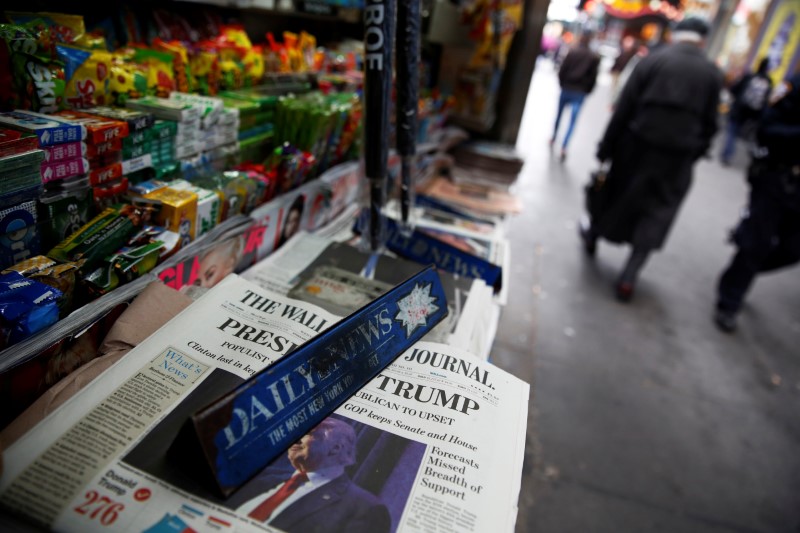By Sheila Dang
(Reuters) - In the days leading up to what is expected to be a chaotic U.S. presidential election, publishers are using new software tools to analyze their news coverage in order to make advertisers more comfortable with placing ads on stories that could be deemed too controversial.
Aiming to avoid a repeat of earlier this year, when news publishers lost an estimated $1.3 billion in ad revenue due to companies pulling ads from stories about the pandemic, major news organizations are using software and human moderators to lure advertisers back.
Gannett’s (N:GCI) USA Today, News Corp’s (O:NWSA) Dow Jones and other publishers contacted by Reuters said they are expecting an increase in companies blocking ads from election-related stories before and after Election Day on Nov. 3.
“Given what’s happening right now and what we know, it will be a challenging time in the news between now and whenever (the election) ends,” said Paul Tsigrikes, head of marketing at the Wall Street Journal and Barron’s Group, which are units of Dow Jones.
Publishers are working to limit the impact of keyword-blocking software that prevents ads from showing up on pages with terms viewed as unsuitable by some advertisers, including "shooting", "dead", "coronavirus", "Black Lives Matter" and "protest."
In a demonstration of how encompassing such keyword lists can be, one publisher showed Reuters a list of nearly 2,000 terms from a major Fortune 500 advertiser that included commonly used terms in news coverage such as “Donald Trump” and “Rudy Giuliani” and other terms referring to violence including “Paris attack” and "Yom Kippur shooting."
These lists, which are now common among advertisers and publishers, would prevent most ads from appearing on election-related coverage, the publisher source told Reuters.
Dow Jones said it is pitching its tool called SafeSuite in "every single meeting" with advertisers. The software helps determine whether an article is considered to have a positive or negative slant, and if the content is suitable next to a brand's ad.
The tool uses a mix of artificial intelligence to understand the meaning of the words in a story, and manual scoring of the articles to determine if it is suitable for a brand's ad, the company said.
Advertisers have long worried about inappropriate ad placements -- an airline ad next to stories about plane crashes, for instance, because digital ad placement is largely determined by tech systems rather than humans.
To avoid this, advertisers have relied on services from ad tech firms like Integral Ad Science (IAS) and DoubleVerify that let advertisers block ads based on words and phrases on pages or web addresses.
In August, IAS launched a product called Context Control, which uses “semantic” technology that determines whether an article has a positive or negative emotion associated with it.
IAS said the technology could also better determine nuances in words and block stories on pages with words like “gunshot” but not on pages with phrases like “basketball shot.”
PUBLISHERS FIGHT BACK
More recently, publishers have built their own tools that use artificial intelligence and machine learning to determine the sentiment of articles.
In some cases, sentiment analysis tools built by publishers have worked better than ones offered by outside ad tech companies like IAS and DoubleVerify.
The third-party tools were sometimes found to block more ad inventory than necessary compared to publisher tools, said Joshua Lowcock, chief digital and innovation officer at ad agency UM.
“The best person to tell you about the content is the person who owns the content,” he added.
Fine tuning these sentiment analysis tools is one crucial aspect to protecting the bottom lines of publishers while still protecting advertisers during chaotic news cycles.
Education also plays a vital role. USA Today’s ad sales team is reaching out to advertisers to explain the benefits of advertising on news, as well as make them aware of softer election coverage like stories that include local voting information, Michael Kuntz, chief operating officer of USA Today Network said.
Dow Jones' ad sales team is also working with the brands to narrow down the keyword lists, said Erin Laughlin, product director of advertising at Dow Jones.
A Dow Jones advertising group that produces custom ad campaigns and sponsored content is seeing increased interest, Tsigrikes said. Advertisers often see such content as brand safe because it is produced in close collaboration with the news publisher.

"There's a lot of anxiety about (the aftermath of) the election, because obviously there could be a lot of craziness," said David Chavern, CEO of news organization trade group News Media Alliance. "We don't want keyword blocks to start hitting legitimate coverage of that controversy."
